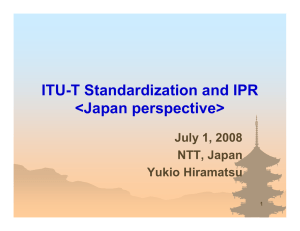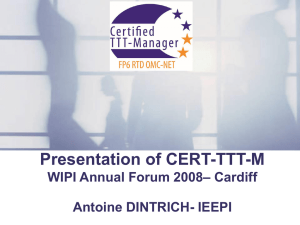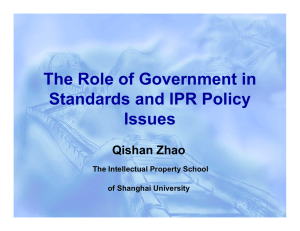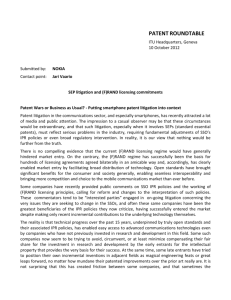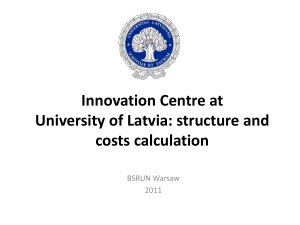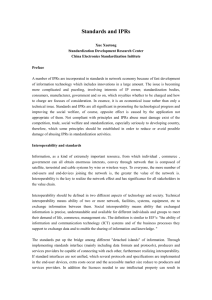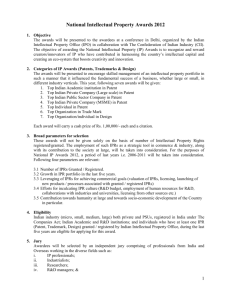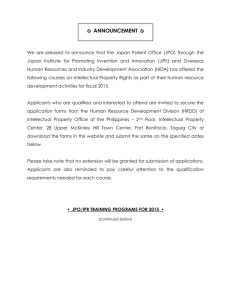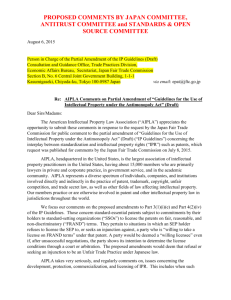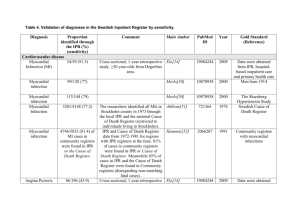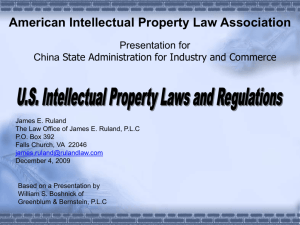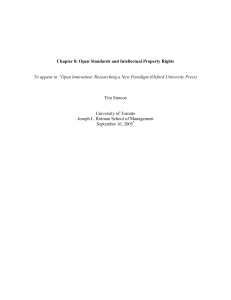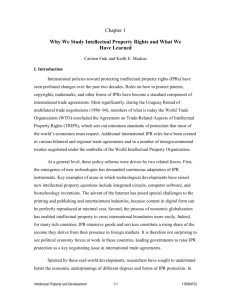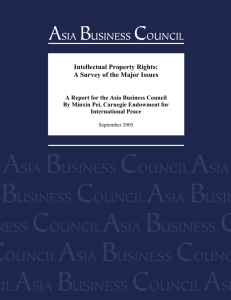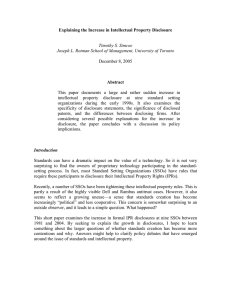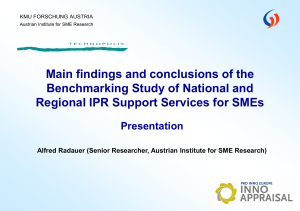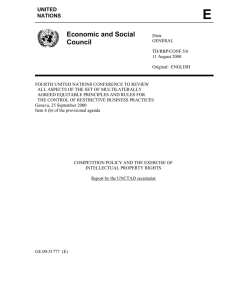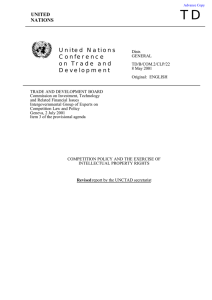patent roundtable
advertisement
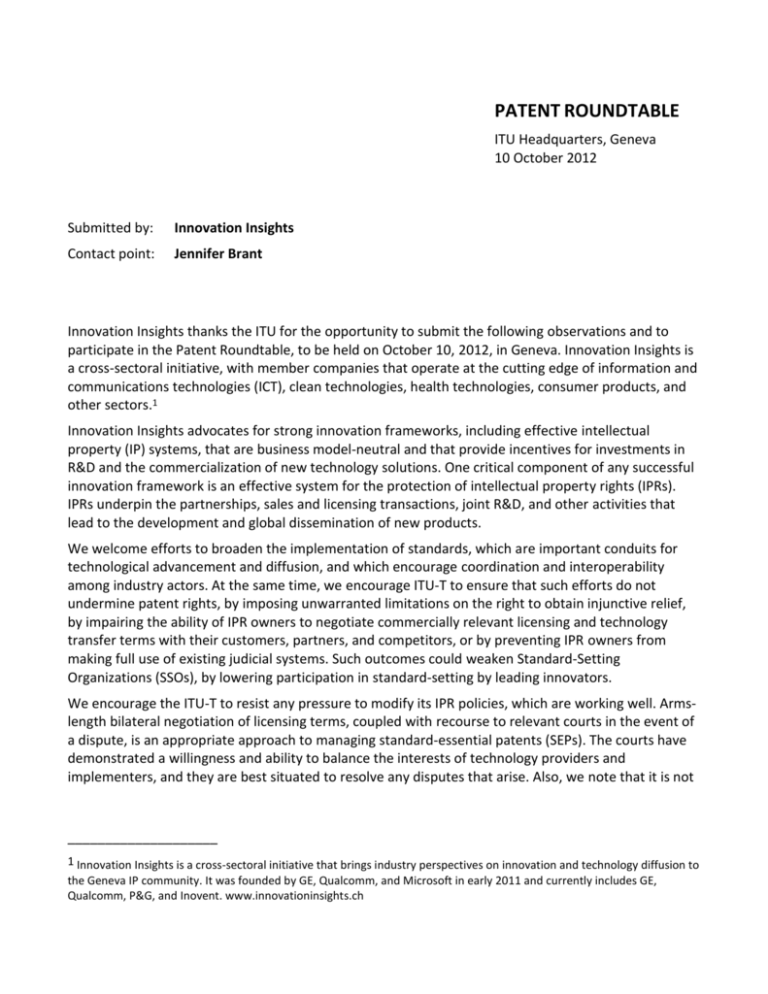
PATENT ROUNDTABLE ITU Headquarters, Geneva 10 October 2012 Submitted by: Innovation Insights Contact point: Jennifer Brant Innovation Insights thanks the ITU for the opportunity to submit the following observations and to participate in the Patent Roundtable, to be held on October 10, 2012, in Geneva. Innovation Insights is a cross-sectoral initiative, with member companies that operate at the cutting edge of information and communications technologies (ICT), clean technologies, health technologies, consumer products, and other sectors.1 Innovation Insights advocates for strong innovation frameworks, including effective intellectual property (IP) systems, that are business model-neutral and that provide incentives for investments in R&D and the commercialization of new technology solutions. One critical component of any successful innovation framework is an effective system for the protection of intellectual property rights (IPRs). IPRs underpin the partnerships, sales and licensing transactions, joint R&D, and other activities that lead to the development and global dissemination of new products. We welcome efforts to broaden the implementation of standards, which are important conduits for technological advancement and diffusion, and which encourage coordination and interoperability among industry actors. At the same time, we encourage ITU-T to ensure that such efforts do not undermine patent rights, by imposing unwarranted limitations on the right to obtain injunctive relief, by impairing the ability of IPR owners to negotiate commercially relevant licensing and technology transfer terms with their customers, partners, and competitors, or by preventing IPR owners from making full use of existing judicial systems. Such outcomes could weaken Standard-Setting Organizations (SSOs), by lowering participation in standard-setting by leading innovators. We encourage the ITU-T to resist any pressure to modify its IPR policies, which are working well. Armslength bilateral negotiation of licensing terms, coupled with recourse to relevant courts in the event of a dispute, is an appropriate approach to managing standard-essential patents (SEPs). The courts have demonstrated a willingness and ability to balance the interests of technology providers and implementers, and they are best situated to resolve any disputes that arise. Also, we note that it is not ____________________ 1 Innovation Insights is a cross-sectoral initiative that brings industry perspectives on innovation and technology diffusion to the Geneva IP community. It was founded by GE, Qualcomm, and Microsoft in early 2011 and currently includes GE, Qualcomm, P&G, and Inovent. www.innovationinsights.ch -2- unusual in emerging areas of technology for companies with competing business models to litigate before adopting different approaches to working together, such as cross-licensing. Standards are a powerful channel for technology development and diffusion. The more than 16,000 internationally agreed standards stimulate faster development of quality technology solutions and their broad deployment, and they contribute to the growth and success of the wireless and other ecosystems. Standard-setting is a voluntary process that involves the identification of the best technology solutions for incorporation in a standard and therefore wider use. That process brings together technology innovators and implementers, which collaboratively make technological choices that shape the evolution of the sector. Standard-setting is a repeat game: the same companies engage in the development of standards again and again, in different SSOs and in relation to different technologies, as the sector evolves. This means there is little to be gained from taking advantage of other participants, for instance by intentionally concealing relevant IPR or demanding unrealistic licensing terms. The nature of the process, including the shared objective of all participants to protect their reputations and to assure continued business success, reduces the risk of so-called “patent ambush” or “hold-up”. It also explains why this phenomenon has not been demonstrated to exist on a significant scale, or to interfere with the standardization process as an important conduit for global technology deployment and diffusion. In fact, experience indicates that standards enable rapid, targeted follow-on and complementary innovation around a particular technology platform. Against this backdrop, it is essential that innovative companies, which invest vast sums in risky and innovative ventures, be encouraged to participate in standard-setting to the greatest extent possible. Unfortunately, the opposite effect would occur if policies are implemented that undermine or weaken the patent rights of technology providers whose solutions are incorporated in industry standards. For example, an absolute bar against injunctive relief or rules that preclude commercial negotiations between parties may reduce incentives to innovate and to contribute innovative technology solutions to standards, since they introduce uncertainty into the marketplace. Innovation Insights believes that innovation – including but not limited to IP – policymaking must support the long-term growth and evolution of the economy. Our member companies employ a range of business strategies, engaging in sales, licensing and cross-licensing, partnerships, and other transactions in order to achieve their commercial objectives. They use IPRs, including patents, trade secrets, trademarks, and copyright, to manage their investments in innovation and the commercialization of new technology solutions. They know from experience that, because innovation comes in many forms, innovation frameworks must support a range of business strategies. And they are keenly aware that IP rights are property rights that are only valuable to the extent they can be asserted and enforced. We are committed to IP and innovation policy-making that supports long-term technological advancement and that is firmly rooted in empirical evidence, including evidence about the potential impact of a given policy. IP systems should not be modified in response to short-term considerations or based on a static “snapshot” of an economy or ecosystem at a given moment in time. Any temporary gains accruing to actors lobbying for such changes will, in all likelihood, be outweighed by longer term damage to the economy or sector in question. Moreover, modification of innovation frameworks can create uncertainty for businesses, interfering with long-term planning and investment. -3- Governments and actors that influence policies that affect innovation and technology diffusion have a crucial responsibility to adopt a long-term perspective. In certain emerging markets, domestic industries that are currently focused on imitation rather than innovation may lobby their governments for weaker IPR protection, or for the imposition of non-commercial licensing or technology transfer obligations for foreign technology providers. Government action to honor such requests may benefit such domestic industries in the short-term (at the expense of innovators, wherever they may be located). However, as domestic industries move up the value chain and become innovators in their own right, such policies may slow this transition and are unlikely, ultimately, to be in these countries’ best interests. In relation to the wireless sector, a similar dynamic appears to be unfolding at the ITU-T and elsewhere. Certain companies are advocating for changes to IPR policies that would allow them to use patented technology on more advantageous terms and improve their market share, their bottom line, or their position in litigation – but which may set back technological advancement, the evolution of the wireless ecosystem, and economic growth. We are concerned that policy proposals with the stated aim of addressing “hold-up” may not be supported by adequate empirical evidence; policy-making cannot be founded on proposals without sound foundation and which risk creating wide-ranging, unintended consequences. It is essential that the long-term welfare and evolution of the wireless sector be prioritized over the interests of specific business models, or short-term gains for a subset of companies. IPR management is highly context-specific, and even the terms of transactions involving the same technology solution can differ significantly depending on the positions of the parties and what each brings to the table. Attempting to predetermine what constitutes a “reasonable” royalty or categorically denying injunctive relief to certain technology providers flies in the face of this reality. Implementation of the commitment to license on RAND terms has intentionally been left flexible to allow parties in bilateral negotiations to come up with terms that make the most sense for them, in their circumstances. Arms-length commercial negotiations remain the best way to ensure that context is appropriately incorporated into technology transfer agreements. Any rule denying the availability of injunctive relief would not only fundamentally alter the balance of interest achieved by the patent laws, it would also significantly limit the prospects of such negotiated agreements being concluded, by reducing the incentives for implementers of standardized technology to engage in such negotiations. As a result, it could lead to more, rather than less, litigation. The current RAND licensing approach, long a feature of all major SSOs, is effective in supporting the adoption and broad deployment of standardized technologies. Courts are best positioned to resolve disputes involving alleged infringement, as reflected in the ITU-T’s long-standing IPR policy. The existing ITU-T approach has provided a foundation for the exceptional innovation, competition, and growth in the wireless sector in recent years, and it should be maintained. _______________
